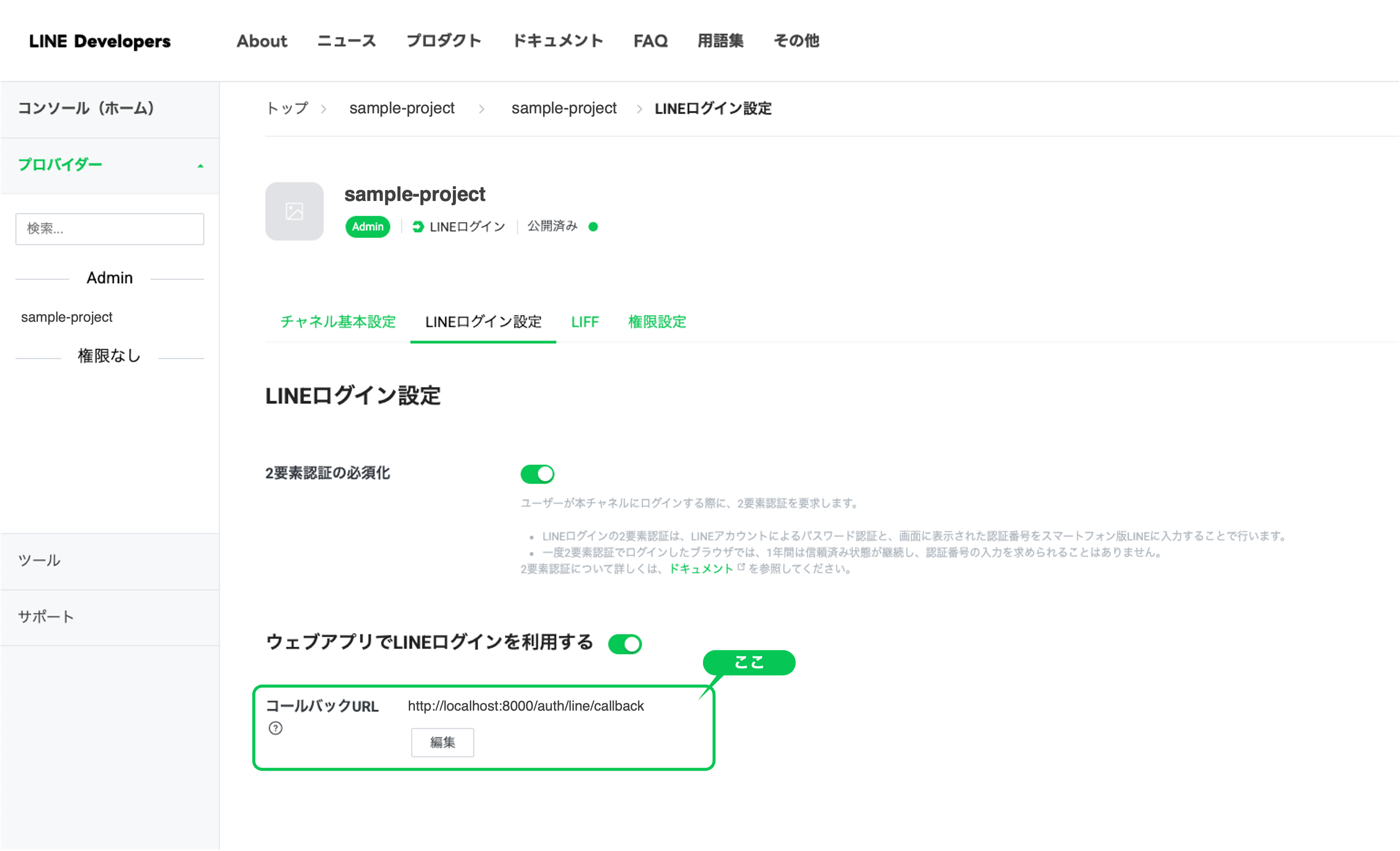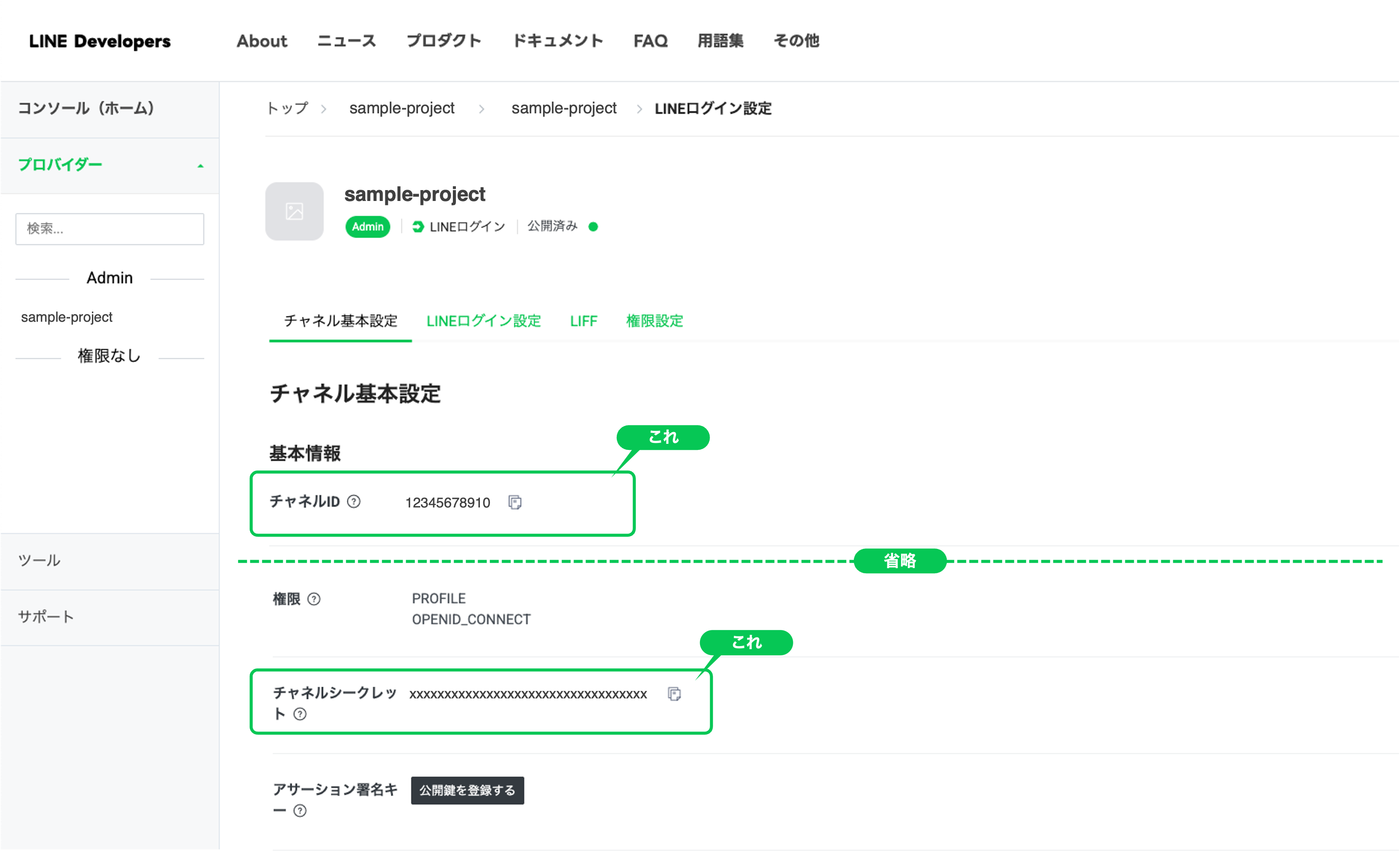こんにちは。最近担当した案件でソーシャルログインを実装した事例がありましたので、
おさらい程度にLINEログインの実装について書き留めておこうと思います。
必要なパッケージのインストール
まず、Laravel SocialiteとLINEプロバイダーをインストールします。
composer require laravel/socialite
composer require socialiteproviders/line
LINE Developersでアプリケーションを作成
- LINE Developersにアクセスしてログイン
- 新しいプロバイダーとチャンネルを作成
- LINEログインの設定で以下を設定:
- コールバックURL:
http://localhost:8000/auth/line/callback - チャネルID と チャネルシークレット をメモ
- コールバックURL:
環境変数の設定
.envファイルにLINEの認証情報を追加します。
LINE_CHANNEL_ID=your_channel_id
LINE_CHANNEL_SECRET=your_channel_secret
LINE_REDIRECT_URI=http://localhost:8000/auth/line/callback
設定ファイルの更新
config/services.phpにLINEの設定を追加します。
'line' => [
'client_id' => env('LINE_CHANNEL_ID'),
'client_secret' => env('LINE_CHANNEL_SECRET'),
'redirect' => env('LINE_REDIRECT_URI'),
],
Socialiteプロバイダーの設定
config/app.phpのproviders配列に以下を追加します。
'providers' => [
// 他のプロバイダー...
\SocialiteProviders\Manager\ServiceProvider::class,
],
app/Providers/EventServiceProvider.phpでLINEプロバイダーを登録します。
<?php
namespace App\Providers;
use Illuminate\Foundation\Support\Providers\EventServiceProvider as ServiceProvider;
use SocialiteProviders\Manager\SocialiteWasCalled;
class EventServiceProvider extends ServiceProvider
{
protected $listen = [
SocialiteWasCalled::class => [
'SocialiteProviders\\Line\\LineExtendSocialite@handle',
],
];
}
マイグレーションの作成
ユーザーテーブルにLINE関連のカラムを追加します。
php artisan make:migration add_line_fields_to_users_table
<?php
use Illuminate\Database\Migrations\Migration;
use Illuminate\Database\Schema\Blueprint;
use Illuminate\Support\Facades\Schema;
return new class extends Migration
{
public function up()
{
Schema::table('users', function (Blueprint $table) {
$table->string('line_id')->nullable()->unique();
$table->string('avatar')->nullable();
$table->timestamp('email_verified_at')->nullable()->change();
$table->string('password')->nullable()->change();
});
}
public function down()
{
Schema::table('users', function (Blueprint $table) {
$table->dropColumn(['line_id', 'avatar']);
});
}
};
php artisan migrate
Userモデルの更新
app/Models/User.phpを更新します。
<?php
namespace App\Models;
use Illuminate\Foundation\Auth\User as Authenticatable;
use Illuminate\Notifications\Notifiable;
class User extends Authenticatable
{
use Notifiable;
protected $fillable = [
'name',
'email',
'password',
'line_id',
'avatar',
];
protected $hidden = [
'password',
'remember_token',
];
protected function casts(): array
{
return [
'email_verified_at' => 'datetime',
'password' => 'hashed',
];
}
}
ルートの設定
routes/web.phpにLINEログイン用のルートを追加します。
<?php
use Illuminate\Support\Facades\Route;
use App\Http\Controllers\LineLoginController;
// 通常のルート
Route::get('/', function () {
return view('welcome');
});
// LINEログイン関連のルート
Route::get('/auth/line', [LineLoginController::class, 'redirectToLine'])->name('line.login');
Route::get('/auth/line/callback', [LineLoginController::class, 'handleLineCallback'])->name('line.callback');
Route::post('/logout', [LineLoginController::class, 'logout'])->name('logout');
// 認証が必要なルート
Route::middleware('auth')->group(function () {
Route::get('/dashboard', function () {
return view('dashboard');
})->name('dashboard');
});
コントローラーの作成
LINEログイン用のコントローラーを作成します。
php artisan make:controller LineLoginController
<?php
namespace App\Http\Controllers;
use App\Models\User;
use Illuminate\Http\Request;
use Illuminate\Support\Facades\Auth;
use Laravel\Socialite\Facades\Socialite;
class LineLoginController extends Controller
{
/**
* LINEログインページにリダイレクト
*/
public function redirectToLine()
{
return Socialite::driver('line')->redirect();
}
/**
* LINEからのコールバックを処理
*/
public function handleLineCallback()
{
try {
$lineUser = Socialite::driver('line')->user();
// 既存のユーザーをLINE IDで検索
$user = User::where('line_id', $lineUser->id)->first();
if (!$user) {
// メールアドレスで既存ユーザーを検索
$user = User::where('email', $lineUser->email)->first();
if ($user) {
// 既存ユーザーにLINE IDを追加
$user->update([
'line_id' => $lineUser->id,
'avatar' => $lineUser->avatar,
]);
} else {
// 新規ユーザーを作成
$user = User::create([
'name' => $lineUser->name,
'email' => $lineUser->email,
'line_id' => $lineUser->id,
'avatar' => $lineUser->avatar,
'email_verified_at' => now(),
]);
}
} else {
// 既存のLINEユーザーの情報を更新
$user->update([
'name' => $lineUser->name,
'email' => $lineUser->email ?? $user->email,
'avatar' => $lineUser->avatar,
]);
}
// ユーザーをログイン状態にする
Auth::login($user);
return redirect()->intended('/dashboard');
} catch (\Exception $e) {
return redirect('/')->withErrors(['error' => 'ログインに失敗しました。']);
}
}
/**
* ログアウト
*/
public function logout(Request $request)
{
Auth::logout();
$request->session()->invalidate();
$request->session()->regenerateToken();
return redirect('/');
}
}
ログイン前後の画面作成
<!DOCTYPE html>
<html lang="ja">
<head>
<meta charset="UTF-8">
<meta name="viewport" content="width=device-width, initial-scale=1.0">
<title>LINEログインデモ</title>
<style>
body {
font-family: Arial, sans-serif;
max-width: 600px;
margin: 50px auto;
padding: 20px;
text-align: center;
}
.line-login-btn {
background-color: #06C755;
color: white;
border: none;
padding: 12px 24px;
border-radius: 8px;
text-decoration: none;
display: inline-block;
font-size: 16px;
margin: 20px 0;
}
.line-login-btn:hover {
background-color: #05B64A;
}
.error {
color: #dc3545;
margin: 10px 0;
}
</style>
</head>
<body>
<h1>LINEログインデモ</h1>
@if (session('error'))
<div class="error">{{ session('error') }}</div>
@endif
@if ($errors->any())
<div class="error">
@foreach ($errors->all() as $error)
<p>{{ $error }}</p>
@endforeach
</div>
@endif
@auth
<p>ようこそ、{{ Auth::user()->name }}さん!</p>
<a href="{{ route('dashboard') }}">ダッシュボードへ</a>
<form method="POST" action="{{ route('logout') }}" style="display: inline;">
@csrf
<button type="submit" style="margin-left: 10px;">ログアウト</button>
</form>
@else
<p>LINEアカウントでログインしてください。</p>
<a href="{{ route('line.login') }}" class="line-login-btn">
LINEでログイン
</a>
@endauth
</body>
</html>
<!DOCTYPE html>
<html lang="ja">
<head>
<meta charset="UTF-8">
<meta name="viewport" content="width=device-width, initial-scale=1.0">
<title>ダッシュボード</title>
<style>
body {
font-family: Arial, sans-serif;
max-width: 600px;
margin: 50px auto;
padding: 20px;
}
.user-info {
border: 1px solid #ddd;
border-radius: 8px;
padding: 20px;
margin: 20px 0;
}
.avatar {
width: 80px;
height: 80px;
border-radius: 50%;
margin-bottom: 10px;
}
.logout-btn {
background-color: #dc3545;
color: white;
border: none;
padding: 10px 20px;
border-radius: 5px;
cursor: pointer;
}
</style>
</head>
<body>
<h1>ダッシュボード</h1>
<div class="user-info">
<h2>ユーザー情報</h2>
@if (Auth::user()->avatar)
<img src="{{ Auth::user()->avatar }}" alt="アバター" class="avatar">
@endif
<p><strong>名前:</strong> {{ Auth::user()->name }}</p>
<p><strong>メールアドレス:</strong> {{ Auth::user()->email ?? '未設定' }}</p>
<p><strong>LINE ID:</strong> {{ Auth::user()->line_id }}</p>
<p><strong>登録日:</strong> {{ Auth::user()->created_at->format('Y年m月d日') }}</p>
</div>
<form method="POST" action="{{ route('logout') }}">
@csrf
<button type="submit" class="logout-btn">ログアウト</button>
</form>
</body>
</html>
まとめ
Laravel 12でLINEのソーシャルログインを実装する方法を紹介しました。Laravel Socialiteを使用することで、比較的簡単にLINEログイン機能を追加できます。
主なポイント:
- Laravel SocialiteとLINEプロバイダーのインストール
- LINE Developersでのアプリケーション設定
- データベースマイグレーションでのLINE関連カラムの追加
- ユーザー認証とデータの保存処理
- エラーハンドリングの実装
この実装により、ユーザーはLINEアカウントを使用して簡単にログインできるようになります。実際のプロダクションでは、セキュリティ面やエラーハンドリングをさらに強化することをお勧めします。
自社サーバ内で可能な限りユーザー情報を持たないというのは情報漏洩の観点でも有効です。皆さんも是非チャレンジしてみてください。

